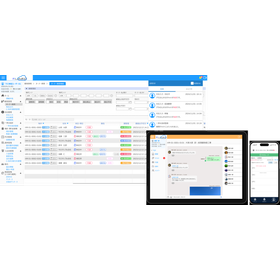Promoting the digitization of field services "ServiceMax"
After-Service Solution "servicemax"
Managing the "Past, Present, and Future" of products with ServiceMax - Supporting after-sales service reform through the digitization of field services!
【Achieving Results Throughout the Lifecycle of Equipment and Devices】 Services for products are necessary throughout their lifetime! Strengthening after-sales service is now required! ◆ An Era of Long-Lasting Products It is possible to manage everything from installation to maintenance and replacement proposals for each individual product. ◆ ServiceMax Target Operations - Delivery and installation preparation - Delivery installation and on-site work - Completion of delivery installation - Maintenance service work - Product replacement proposals ◆ ServiceMax Features - Management of installation images and implementation reports for each individual product - Centralized management of component configurations of installed equipment in collaboration with PLM and ERP systems - Development of regular inspection schedules for each individual product and service part - Improvement of on-site work through the use of tablets - Visualization of field services
Inquire About This Product
basic information
【Basic Functions of ServiceMax】 〇 Installed Base Management - Management based on product configuration at delivery and acceptance - Management of product configuration updates - Service history (location/account) 〇 Contracts, Warranties, and Qualifications - Template creation for service contract plans - Creation of estimate and billing data 〇 Service Execution - Advanced work instructions | Schedule management (schedule optimization) 〇 Business Processes - On-site work (installation, repair, inspection, parts replacement, safety checks, etc.) - Pickup work (cleanup, repair, inspection, parts replacement) 〇 Returns and Warehouse Repairs - Tracking and management of returns 〇 Service Business Analysis - Analysis tools
Price range
Delivery Time
Applications/Examples of results
○Purpose - Management tasks for the future state of the product - Field service tasks related to the product - Product installation tasks - Product maintenance service tasks - Product parts replacement history - Failure response history - Product recall management - Proposals for product replacement
Detailed information
-

A malfunction has occurred in the equipment manufactured and sold... 1. A malfunction call is received from the customer at the call center. 2. A technician with the required skills is dispatched as quickly as possible. 3. The dispatched technician obtains the necessary information for repairs from the field. 4. The technician performs repairs while referring to the manual on-site. 5. A trusted technician proposes an update for maintenance. 6. The service operations are analyzed, and KPIs are checked.
-

Check the basic information and product configuration (BOM) of the installed equipment where a malfunction has occurred.
-

At the customer service desk, check the warranty of installed products, past repair history, details of IoT sensors, etc., to understand the overall situation regarding repairs.
-

The system automatically recommends technicians considering complex dispatch conditions.
-

The technician can prepare for on-site work from a remote location.
-

Refer to the product manual materials as needed at the work site. Support the increase in the first-time repair rate and the reduction of average repair time.
-

A trusted technician proposes maintenance renewal for the next fiscal year. By offering not only maintenance contracts but also parts and options, service revenue is increased.
-

Improve service execution and accelerate the digitalization/efficiency of service operations by analyzing "key indicators for enhancing business effectiveness and efficiency": - First repair rate - Average repair time - Average response time - Maintenance contract signing rate - Average task completion time - Personnel utilization rate - Product operating rate - Revisit rate - Mean time between failures
catalog(1)
Download All CatalogsCompany information
Since our founding in 1966, we have expanded our business areas in response to the demands of the times, evolving from software development to device development, then to system integration, and further into cloud services centered around data center operations. What has remained consistent since our inception is our customer-oriented approach, which emphasizes that "the center of business is always the customer, and we work in unison with our customers," along with our people-focused philosophy of "maximizing the potential of each employee." We also consider our commitment to CSR aimed at realizing a prosperous society to be an important mission, and we are dedicated to social contribution activities such as resource and environmental conservation efforts, community beautification initiatives, blood donation, and support for disaster victims. Our corporate philosophy, "Humanware By Systemware," embodies our desire to "enrich society through excellent systems." Moving forward, we will continue to leverage our technology, knowledge, and creativity to create "valuable systemware" that meets the needs of the new era and earns the trust of our customers, shareholders, and society.



![[AiCube User Case] Hokuetsu Paved Road Co., Ltd.](https://image.www.ipros.com/public/product/image/1b6/2000511209/IPROS05203494763397637501.png?w=280&h=280)

![[TM-RoBo Implementation Case] Daikin Industries, Ltd.](https://image.www.ipros.com/public/default/object/noimage_l.gif?w=280&h=280)

![[Knowledge Suite Implementation Case] Yasukawa Seimai Co., Ltd.](https://image.www.ipros.com/public/product/image/bd5/2001514021/IPROS5154012203211082742.png?w=280&h=280)


![[Document] Procedure Manual After Implementing HubSpot <Sales Hub Edition>](https://image.www.ipros.com/public/product/image/2117561/IPROS4305148353615031865.png?w=280&h=280)
